
“Misery! We have known each other,
Like a sister and a brother
Living in the same lone home
Many years – we must live some
Hours or ages yet to come…
…Kiss me; - Oh! Thy lips are cold:
Round my neck thine arms enfold
They are soft, but chill and dead;
And thy tears burn upon my head
Burn like points of frozen lead.”
--Percy Bysshe Shelley
“Invocation To Misery”
1818
The
Hand Of Doom
~By Matthew
Heilman
As with all great musical monarchies and
legacies, the throne of Doom was first erected in England. Where,
in 1968, a band by the name of Earth sought to shake the very foundations
upon which they tread with the darkest, most ominous melodic rumblings
yet known. They later donned the moniker Black Sabbath, and became
the premier heavy metal band to inspire legions upon legions of faithful
successors. At a time when music was perfumed in flowers and emitting
rays of optimistic sunshine, this quartet of Birmingham lads invoked an
eclipse that has yet to be penetrated. They spiraled into an abyss
of depressive psychology, occultism, and fantasy, and indeed took political
and anti-war stances with such classic gems as “War Pigs” “Electric Funeral”
and “Children Of The Grave.” Yet their message was not diluted with
the faux optimism of the then contemporary rock bands, but rather imposed
a sincere realism and pessimistic preparation for the worst. The
legitimacy of Sabbath’s approach was seen in their lyrics which intimately
warned the dangers of hard substance abuse (“Hand Of Doom” and “Snowblind”)
as well as a light-hearted tribute to the “sweet leaf.”

Sabbath were complex, outcasts, and shocking
for their time. Yet with the unholy wail of Osbourne paired with
the consumptive walls of dense guitars and vibrato licks of Iommi set to
the bass backbone of Geezer Butler and thunderous pound of drummer Bill
Ward, the standards were etched in stone for the future of heavy metal.
Like contemporaries Led Zeppelin, Blue Cheer and Iron Butterfly before
them, Sabbath took the meshing of hard rock with blues and stirred in another
ingredient of decayed emotion. Instead of upbeat rock n’ roll jam
sessions, they churned out sluggish dirges, birthing something menacing
and pungent with gloom to forge the darker, left-hand path of metal music.
Sabbath lurched throughout the 70’s, self-destructing
in 1979 to close the legendary chapter of the band with “Never Say Die,”
the last mediocre album that Osbourne appeared on. Sabbath and Ozzy
parted ways, Sabbath to recruit Ronnie James Dio of Rainbow fame and Ozzy
to pursue a monumental solo career. The rest is history.
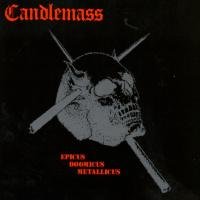
With that I take you through the late
70’s and early 80’s. Skipping over the important yet not particularly relevant
topic of the NWOBHM (New Wave Of British Heavy Metal) with Iron Maiden
and Judas Priest and treading over the thrash metal explosion led by Metallica,
Megadeth, Slayer, and Anthrax, to reach an important milestone in Doom
metal history. The aforementioned bands took metal to new heights
as well, evoking epic grandeur while relying more on technicality and speed,
yet their bastard miserable brothers were the bands that resisted that
temptation and strove for the antithesis. By way of stark minimalism,
bands such as Candlemass, Celtic Frost, St. Vitus, and the latter 80’s/early
90’s bands like Solitude Aeternus and Cathedral, were more concerned with
density, heaviness, and basic rhythmic structures. Less flashy, painfully
slow, and interested more so in the emotive potential of their music, these
bands were arguably the first formalized acts accredited to the ‘doom’
metal genre. Further expanding the boundaries of the music, Candlemass
and Celtic Frost began to integrate orchestral elements to the music, with
very subtle keyboards, rare female back up vocals, and an application of
classical composition.
It is rather presumptuous of me to really
attempt to pigeonhole these bands as they all had their differences and
went opposing directions from one another. But one thing remains
for certain; these bands foreshadowed and inspired what was to come, taking
the work of Sabbath and contributing an even more unique quality to the
music, and paved the way for the most striking metamorphosis of the genre.
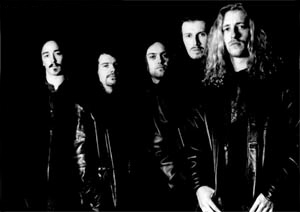
‘Twas again in merry ol’ England
(a pun?) where dark metal underwent a significant and drastic change.
The misty moors and rich literary history fostered the emergence of three
bands that were to change the face and potential of doom metal forever.
In late 1989, Paradise Lost appeared first upon the scene, a quintet out
of Halifax that took the sluggish pace and mood of doom metal, fused it
with the vocal grunts and angst of death metal, and introduced a more elaborate
use of symphonic keyboards and female back up vocals. With their
debut release “Lost Paradise” and the aptly titled follow up, “Gothic,”
the band blew the doors of innovation wide open.
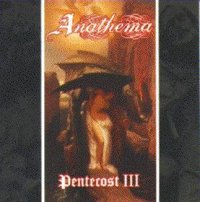
Following shortly thereafter the second
of the ‘big three’ arose, and the world was introduced to the mournful
melodies of Anathema. Perhaps the most intensely melancholic ‘crestfallen’
assemblage of dark metal material appears on the bands debut release “Serenades”
and the succeeding EP “Crestfallen.” Fueled by despondent twin guitar
harmonies, loathsome death growls and lethargic clean vocal harmonies of
Darren White, the band courted a destructive bleakness otherwise unknown
to the average metal fan. Depressive yet undeniably beautiful, Anathema
was absolutely awe-inspiring at their emotional intensity. Further
experimenting, the band released “Pentecost III” which to this day is one
of my own personal favourite CDs of all time. Resplendent watery
guitar arpeggios, woeful recitatives, and overwhelming ghosts of harmonized
guitar swells made the CD an uneasy listen and an immortal milestone in
sorrow-fueled music. The album housed such tracks as “We, The Gods”
and “Kingdom” and marked the last appearance of Darren White as vocalist.
Backing up only a few years however, just
at the same time as Anathema and Paradise Lost cast their shadows o’er
England, a sextet of broken-hearted balladeers appeared, none other than
My Dying Bride. My Dying Bride could be regarded as the most ambitious
of the big three, in terms of experimentation in some respects, in that
their distinctive blend of blistering death metal and traditional doom
was accentuated by the use of a live violinist. In doing so, the
symphonic element became more organic and genuine and added a blissful
touch of avant-garde atmosphere, marked even further by the archaic, Shakespearean
inspired prose housed within the lyrics. Drawing from Epic Literature
and mythology, vocalist and lyricist Aaron Stainthorpe defied the limitations
of traditional death metal lyrics to evoke a more classical, tragic style
on the debut “As The Flower Withers” and the two early EP’s “The Thrash
of Naked Limbs” and “Symphonaire Infernus…” It is because of this, and
the undeniably hypnotic mood of the music and the lyrics that earned the
tag ‘Gothic metal.’ Not as many mistake as an influence from the punk/new
wave ‘Gothic’ of the Sisters Of Mercy or Bauhaus (not yet anyway), but
more from a literary standpoint. The music of My Dying Bride and
Anathema could easily serve as a score to the Gothic tales of 18th and
19th Century works of Matthew Lewis, Horace Walpole, Shelley, Byron, Coleridge,
and others. The beautiful is wed to decay, the anguish of death personified
in the monstrous vocals and the drafty mood evoked by the pale Romantic
melodies.
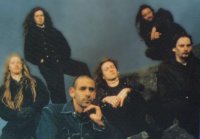
My Dying Bride has once been quoted on
their lyrics as saying: “It is one thing to write about chopping off someone’s
head and playing football with it, but it is altogether different to write
about picking up the pieces after death.” The band achieved their
first triumph with the second full-length “Turn Loose The Swans,” where
all the elements that made up My Dying Bride were perhaps at their most
piercing. By volleying between both dark death growls and an unsteady
lovelorn tenor, increasing the roles of piano and violin, and strengthening
the fluid impact of the guitar work, My Dying Bride perfected their trademark
sound and released an unparalleled CD that was instantly hailed a cult
masterpiece.
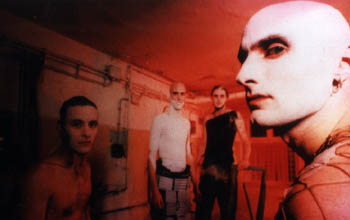
All three bands matured and ventured off
into their own destined territories, never losing touch with the genuine
emotion that fueled their music, but began to explore other ways to express
their visions. Their impact upon the dark music scene caused a veritable
floodgate of creativity to burst throughout Europe. Scores upon scores
of bands picked up on their ideas and formulated their own unique interpretations
of the ideas crafted by these bands and the atmospheric Gothic Doom Metal
scene of today was born. First with Sweden’s Tiamat, Finland’s Amorphis,
Celestial Season, and The Gathering in the Netherlands, Moonspell in Portugal,
and perhaps the most eloquent and extreme art to emerge was Norway’s Theatre
Of Tragedy, a septet of epic orchestral grandeur and theatrical melodrama.
And on through the mid nineties, spearheaded as well by the semi-commercial
success of Type O Negative in the US, and hosts of new blood by way of
Katatonia, 3rd & The Mortal, Within Temptation, Tristania, Skepticism,
Orphanage, Decoryah, Sadness, Morgion, and Crematory.
By now, the scene has exploded. And
though it is still rather controversial and hard for many to accept that
any kind of heavy metal music could be considered romantically depressive,
sad, or beautiful, there are many bands that are proving it is more than
possible. More and more bands are experimenting with melodies and
symphonic elements, and many of the aforementioned bands, most notably
Tiamat, Moonspell, and The Gathering, did in fact cull influences from
traditional Gothic rock and contemporary Darkwave/Industrial music.
In fact, with these bands often acknowledging their Gothic influences,
many metal heads were first introduced and learned to appreciate the works
of Goth rock related bands such as Fields Of The Nephilim, Christian Death,
Swans, Depeche Mode, Dead Can Dance, and the Sisters Of Mercy.
Indeed, it is tedious and often extremely
controversial to attempt to categorize, pigeonhole, or define these bands.
And it is here that I will not to avoid bias that many bands did not catch
the wave of Gothic inspiration. Instead, fueled from Sabbath and
St. Vitus’ groove oriented sound, a breed of ‘stoner’ metal branched off
and is still widely successful today. Bands such as Cathedral, Amorphis,
and sadly Celestial Season took this cue and integrated a more 70’s prog
rock feel to their music and abandoned the atmospheric trappings all together.

They, among many do not feel that Gothic/Symphonic
elements belong in metal music, especially now as these themes have crossed
over into the Black Metal scene largely due to success of the outrageous
and controversial Cradle Of Filth. Indeed, there are several bands
that sprung up throughout the craze and were obviously jumping on a bandwagon,
and churned out passionless drivel that mocked the integrity of the genre,
but they faded and faded fast. Regardless if all approve or enjoy
the fusing of these styles, there are many that find an important amount
of solace within this music, and a place to escape. Leading record
labels such as Century Media, Nuclear Blast, Relapse, Napalm, Peaceville,
and Dark Symphonies recognized the success of these bands, and have consistently
helped keep the experimental metal barge afloat. Thus, atmospheric
Gothic metal is accessible to legions of faithful and solitary fans on
all continents, which embrace the genuine beauty of the music.
And thankfully, this next generation is responding by producing their own original contributions to the longevity and expansion of the genre.
Mp3.com, the most widely used downloadable
music Internet site, is perhaps the hottest source for the newest and most
promising Gothic Metal bands. Within the past month alone, I have
accidentally stumbled across some of the most passionate, inspired, professional,
and overwhelmingly gorgeous Gothic Metal bands I could ever hoped to imagine.
In many ways, they seem to be grasping back to the origins of older Anathema,
Paradise Lost, and My Dying Bride and picking up where they would have
left off. There is about a fifty/fifty split between these more traditional
doom bands and those that have taken to the orchestral, symphonic tendencies.
However, both styles of bands use their gifts with restraint and eloquence.
For more in-depth reviews of Gothic Doom metal releases, please see our
CD REVIEW section, though for now I would like to turn the spotlight on
the future leaders of the Gothic Doom metal scene.

The most strikingly pensive and bleak
newcomers are without a doubt Virginia’s Necare. Honourably inspired
by Anathema, Saturnus, and Septic Flesh, the project began as an emotional
outlet for principle songwriter Ryan Henry. With themes inspired
by unrequited romance, mutability, and the eloquence of Edwardian and Pre-Raphaelite
art, Necare take abrasive early Gothic Doom and blend it with soothing
guitar melodies. Ryan paired up with drummer Greer Cawthon, a session
viola player and back up female vocalist. Gathering all the elements,
with a steady focus on guitars and light on the symphonic touches, Necare
recorded an EP entitled “Ophelia” late last year. Having only recently
been added to Mp3.com, the band has generated a number of hits and downloads,
setting the Doom metal charts ablaze with preview tracks such as “The Mourner”
and “Eleanor” from the debut full-length “Rite Of Shrouds,” which is due
for release in late December or early January. With their conviction
and eloquent artistic presentation, it is certain that fans of dark metal
will be hearing more from these guys in the near future.
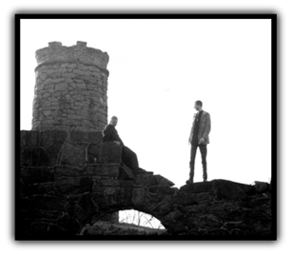
Throughout the month of October, the number
one Gothic Metal chart position has been dominated by Forest Of Shadows,
a duo of musicians from Gothenburg, Sweden. The music of Forest of
Shadows, is not exactly the standard Gothenburg style, but rather a despondent
brand of colossal Gothic Metal, compiling the stark romanticism of twin
guitar harmonies, weeping violin passages, deep death vocals, and gorgeous
vocal passages sung in a choir like fashion. The multitude
of acoustic guitar breaks, galloping power metallics and epic lengths of
their tracks recall some of the higher points of Opeth yet the appearance
of violin, overall mood, and lyrical content is certainly along the lines
of My Dying Bride and the like. There is no question as to why the band
has been reigning at the top of the charts, having made over $3,000 on
Mp3. Their music is majestic, absorbing, and painfully beautiful.
Truly an awe-inspiring band! Three short EP’s are available from
the band, two of which are available as DAM CD’s at Mp3, and hopefully
it will not be too long until they release a more concise and longer collection
of both old and new material.
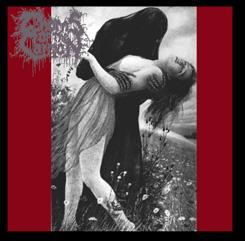
Cincinnati’s Thorns Of The Carrion have
been recording music sine the mid nineties, and have just recently released
a five song mini-CD entitled “Eve Songs.” But it was their monumental
1997 release “The Scarlet Tapestry” that their niche in the Gothic Doom
metal scene was carved. Smothering the listener with woe, the 73
minute opus was a testament to forlorn Romanticism, as heard on such shining
gems as “The Tragedy Of Melpomene” and “Bleak Thorns Laurels.” TOTC
pair the foreboding vocal styles and standard rhythmic elements of death/doom
metal with exquisite melodies, acoustic guitars, harps, and flutes.
In doing so, the band triumphs in creating a sullen mood of rapturous bleakness.
Both the full-length CD and new EP are available directly from the band
at their website. Look for more information and reviews of Thorns
Of The Carrion in future issues of Starvox, but until then, brave the descent
into their world on your own!

Hailing from Philadelphia, PA, Season
Of Mourning are yet another American band raising eyebrows in the dark
metal underground. A guitar driven seven-piece, capped by a somber
male voice, sparse female vocals, and subtle violin, the band blends the
groove-oriented elements of doom with ambience and flashes of traditional
Gothic Rock. Despite the absence of guttural vocals, the band’s crushing
guitar crunch likens them to the heavier, less keyboard drenched bands
of old. Nonetheless, Season Of Mourning sport a strong blend of atmosphere
with deathly doom metal. The occasional violin passages are done only when
they seem most necessary and even the upbeat Sisters Of Mercy-esque “Blood
Like Wine” still comes across as heavier such a comparison would suggest.
For Season Of Mourning, density is the key, and the thickness of their
sludge is utterly remarkable. The band handles and promotes their
own material, and with one short EP “In Praise Of The Dark” under their
belts, they have begun to earn a name in the eastern PA area for their
reputed liver performances. The debut EP is now available through
the band’s official website.
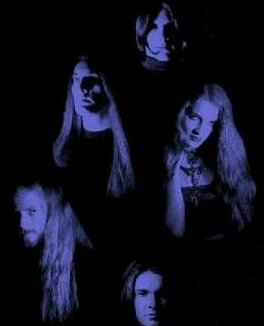
Featured in Starvox this past Spring,
another Virginia based band has been causing quite a stir in the progressive
metal genre, the female fronted Rain Fell Within. Signed to Dark
Symphonies records early this year, the band has released the immaculate
EP “Believe” which features perhaps the most feverish displays of operatic
female vocal potential within the genre. Vocalist Dawn soars above majestic
galloping guitar riffs and sweeping keyboards, for an uplifting charge
of driving intensity. The band is currently at work on their first
full-length release, and have had several East Coast concert appearances
over the past few months, as well as this past year’s Milwaukee Metalfest.

One of the more unique additions to the
atmospheric metal roster are New England’s Maudlin Of The Well, a progressive
and unpredictable cornucopia of sullen music. Also featured in a
Spring issue of Starvox, the band still hasn’t received the recognition
I believe they deserve. Head on collisions of thrash metal, space
rock, progressive jazz, and of course Gothic doom help Maudlin stand apart
upon their own sacred island in the dark metal world. Their amazing
track “Catharsis Of Dream Sleep” is simply breathtaking. The nine-minute
plus song yields some arresting guitar and clarinet arrangements that segue
into a harsh old school death/doom break. From their the song crests
to reach a heart wrenching, sluggish finale. This and many more tracks
appear on their mp3 site and on their debut Dark Symphonies release “My
Fruit Psychobells…A Seed Combustible”
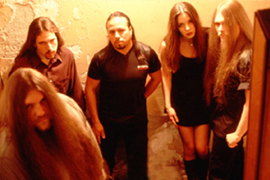
Yet again, another surprise from the States
by way of Novembers Doom. Having formed in the mid nineties outside
of Chicago, the band has released two full lengths and one EP, and they
are just getting ready to unveil their latest opus through Dark Symphonies
records, entitled “The Knowing.” November’s Doom stands apart
quite a bit from other doom acts, and it is almost hard to pinpoint exactly
how. Though the style of guitar playing and multiple dark Gothic/guttural
voices and such are all pretty typical to the genre, all these elements
are delivered in a very unique and unexpected way. They are pure
Gothic Doom from head to toe, but their brand of darkness is unlike any
other. Keyboards are not relied on to keep the band afloat, save
for a few random interludes or intros to songs; rather dense atonal guitars
carry the mood along atop shifting, complex rhythms and pounding drum dirges
or swinging groove oriented breaks. The band had promised that the
newest release is to be their best and most diverse work yet, and that
is without question an accurate prediction. Dark metal fans can be
assured that November’s Doom will be a force to reckon with in this genre
for years to come.

Perhaps the most popular of acts stirring
up buzz over the past few years are Norway’s Sins Of Thy Beloved, an overwhelmingly
theatrical outfit. They may or may not need an introduction to some, but
there are still many who are missing out on their brand of energetic Gothic
Metal. Similar in the duel male/female vocal trades of Theatre Of
Tragedy, TSOTB stand out for a devilish and frenzied fiddle player, that
fuses a Celtic and Classical virtuosity to the tightly woven guitar heavy
drive of the band. Their debut CD “Lake Of Sorrow” turned heads instantly
with its fresh energy and approach, and further solidified its hold as
leaders in the scene with their recent CD “Perpetual Desolation,” both
of which are products of Napalm Records.

A brand new band has surfaced from Austria,
also on Napalm Records, however not as grandiose in scope as label mates
Tristania or Sins Of Thy Beloved. Rather, Darkwell deliver a nice
blend of power metal and somber Goth rock inspired ambience. Fans of traditional
Goth music might want to note that Darkwell are barren of harsh male vocals,
opting instead to push the soft, honeyed vocals of Alexandra Pittracher
to the forefront. Stirred up only by occasional spoken male parts
and symphonic keyboard work, the band does still retain a mid-paced drive
and genuine heaviness as the guitars make up the bulk of what you hear
in the band’s sound. A truly pleasant mix of styles, catchy hooks,
and memorable melodies comprise the band’s debut “Suspiria,” which was
just released this month by Napalm.
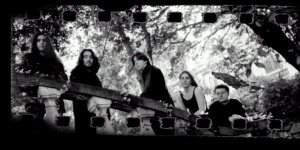
From Spain, the outfit Growing Cells hearken
to the heydays of traditional thrash and heavy metal, and wed it with female
fronted power metal. Melodic serenades are stirred by unexpected
blast beats and raspy sandpaper screams, but a great concern for melody
is not overlooked. A self-titled demo debut appeared in 1998 and
the band is currently at work on their next CD, which will further experiment
with the styles and approaches they began to explore.

Hailing from Croatia, another great export
comes by the way of Ashes You Leave. A somewhat obscure band, though
puzzling as their music is quite ambitious and distinctive, due mainly
to deeper, brooding female lead vocals. They also make use of the
violin, and are most characterized by eerie harmonizations and plodding
drums. I haven’t heard much from the band, barring the title track
from their last release “A Passage Back To Life.” However, Ashes
You Leave is one of those rare and special bands who deliver an inescapable
claustrophobia that is irresistible, despite its tendency to unsettle.
But that is the beauty of doom metal though isn’t it? Judging from
the cut on Mp3.com, I do not think it is a one-shot deal with these guys.
Be on the look out for their newest release “The Inheritance Of Sin And
Shame.”

The last of numerous US projects to be
seduced by the romanticism of Gothic Doom metal is the Pennsylvania project,
All Hope Lost. Though still in the early developmental phases, All
Hope Lost is quite an ambitious project with three full length CDs and
one EP to their credit, and two more full-lengths slated for an early and
mid 2001 release. With a heavy lyrical focus on unrequited love,
the project’s mini CD "The Glow" deals with the beauty and promise of love
in its infancy ('the glow' of a new relationship) and then its gradual
deterioration until its very bitter end. Though limited in its home-recorded
analogue production, the project is currently at work on improving the
quality of sound and strengthening the impact of dueling male/female vocals.
It is quite possible that once graced with a more professional production,
All Hope Lost may rank among the next wave of atmospheric Gothic Metal
spearheaded by the dozen aforementioned bands featured above.
Thus, with the creep of Winter chill and the Autumnal trees dying in beautiful colours along the landscapes the world over, rejoice in the isolation and despair offered by these hardworking new artists, as well as their forefathers if you have yet to experience their brooding symphonic metal mastery.
“In the mist of falling leaves in a
garden of endless grief,
I yearn for thee my precious one.
Beneath the pale lit sky I dream of
your embrace
How I wish I had you near.”
--FOREST OF SHADOWS
“Wish”
Black Sabbath:
http://www.blacksabbath.com
Candlemass:
http://www.geocities.com/~sulinski/candlemass/candlemass.html
Celtic Frost:
http://www.celticfrost.com/
Solitude Aeternus:
http://www.solitudea.com/
Cathedral:
http://www.geocities.com/~witchblaster/
Paradise Lost:
http://www.paradiselost.co.uk/
Anathema:
http://listen.to/anathema
My Dying Bride:
http://www.mydyingbride.org
Theatre Of Tragedy:
http://www.theatreoftragedy.com
Tiamat:
http://www.wildhoney.org
Moonspell:
http://www.butterfly-fx.com
Katatonia:
http://www.katatonia.com
3rd & The Mortal:
http://home.nvg.org/~thomasr/mortal/
Type O Negative:
http://www.typeonegative.net
Necare:
http://www.geocities.com/Tiphareth231/necindex.htm
http://www.mp3.com/necare
Season Of Mourning:
http://www.seasonofmourning.com
http://www.mp3.com/seasonofmourning
Forest of Shadows:
http://www.mp3.com/FoS
http://darkmetal.com/forestofshadows/
Thorns Of The Carrion:
http://www.mp3.com/thornsofthecarrion
http://www.geocities.com/carrionthorn/
Novembers Doom:
http://www.novembersdoom.com
http://www.mp3.com/novembersdoom
Growing Cells:
http://growingcells.cjb.net/
Rain Fell Within:
http://www.rainfellwithin.com
http://www.mp3.com/rainfellwithin
Darkwell:
http://www.darkwell.org
http://Darkwell.cjb.net
http://www.mp3.com/darkwell
Sins Of Thy Beloved:
http://www.tsotb.com
Ashes You Leave:
http://www.mp3.com/ashesyouleave
All Hope Lost:
http://www.mp3.com/allhopelost
http://www.angelfire.com/pa3/allhopelost
Nuclear Blast Records
http://www.nuclearblast-usa.com
Century Media Records:
http://www.centurymedia.com
Relapse Records:
http://www.relapse.com
Peaceville Records:
http://www.peaceville.com
Napalm Records:
http://www.napalmrecords.com
Dark Symphonies Records:
http://www.darksymphonies.com
Hand of Doom Logo by Simon Marsden
http://www.marsdenarchive.com
All images are gracefully borrowed, and are copyright and property of the artists and the owners of their official respective websites. Neglectful use is prohibited.
1/10/00
